First Tableau:
The scene is set in a square in St. Petersburg where a
Shrovetide Fair is in full swing. From the very beginning, the atmosphere of
feasting and celebration before the abstemiousness of the Lenten season can
be felt. The carnival mood is enhanced by the presence of stalls, booths and
small "acts": there is a barrel organ playing and dancers take turn
entertaining the assembled crowds.
Drums roll and from one of the booths appears a
Magician. To the accompaniment of his flute, three motionless puppets are
revealed to the entranced public: Petrouchka, the Ballerina and the Moor. At
the given signal from the Magician, the three puppets spring to life and
perform the vigorous danse russe. To the delight of the crowd, the
three puppets act out a dumb show: both Petrouchka and the Moor are in love
with the Ballerina; she shows favor towards the Moor. Jealously, Petrouchka
attacks his rival. At this point, the Magician signals for the drama to
cease, whereupon the Russian Dance resumes until the curtain comes down on
the first Tableau.
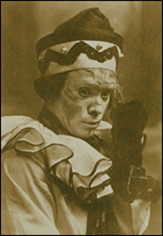
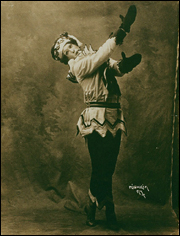
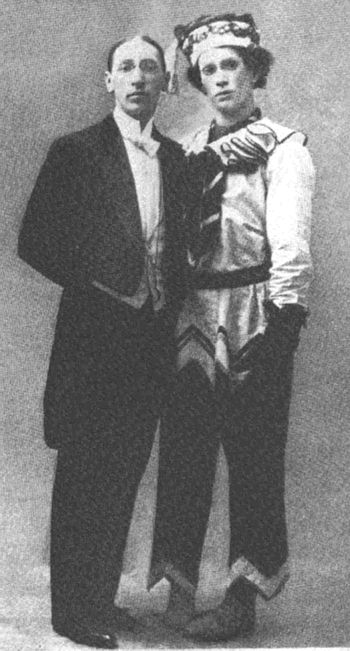
Nijinsky
Nijinsky and Stravinsky
Behind the stage, Petrouchka is returned to his cell.
We now become aware that the puppets have been endowed, through the
mysterious powers of their master, with human feelings. Petrouchka is in
despair: he longs for human form, an existence to match his human desires
and freedom from the Magician's wicked enslavement. A sad, somber dance
reflects his mood. This dejection rapidly transforms to delight at the
entrance of the Ballerina. Petrouchka dances eagerly around, trying, in
vain, to attract her attention and to win her love. Instead, she is simply
disgusted and soon leaves. He is now beside himself with anguish and
endeavors to escape his torment by fleeing his cell. He fails and falls to
the floor.
We move to the room of the Moor, who is idly relaxing
in an opulent setting, playing with a coconut. Drums roll again and the
Ballerina dances in to the accompaniment of a horn. Together they dance a
waltz and the Moor begins his seduction of the Ballerina. She feigns
resistance when the Moor pulls her violently towards him, but is secretly
delighted. Their amorous behavior is suddenly interrupted by the entry of
Petrouchka, who jealously scolds the Moor for his treatment of the
Ballerina. The Moor draws his sword and chases Petrouchka. The Ballerina
faints and Petrouchka narrowly escapes in a dash of the door. The dumb show
acted out before the crowds earlier has now been enacted in reality.
We move outside again to the carnival now. The evening
crowd is being entertained with dances by Wet-Nurses, a Dancing Bear,
Gypsies, Coachmen, and the Masqueraders. The mood of gaiety is dramatically
transformed to one of horror by the sudden appearances from their booth of
Petrouchka being frantically pursued through the crowd by the Moor, who
catches him and strikes him dead. But the stunned people are convinced by
the Magician that Petrouchka is only a puppet made of straw and wood, and
they slowly disperse. However, as the Magician turns to move back inside, he
sees the ghost of Petrouchka threatening him from the roof of the theater.
Le Spectre de la Rose
The curtain rises on an elegant bedroom. A young girl
enters, returning from the Ball, and removes her cape to reveal a beautiful
ball-gown. She dances around her bedroom, deep in thought, recalling the
excitements of her first Ball. She is in love and clutches in her hands the
red rose given to her by her lover. She sits down exhausted and is soon
asleep, the rose slipping from the fingers to the floor.
Suddenly, to the accompaniment of an exhilarating waltz, the spirit of the rose springs in through the window and dances around the room. He awakens the girl, in her dream, and they join in an ecstatic waltz together. They dance on and on, and the romantic dream-picture is complete. But the dream cannot last and the girl returns to her chair as before, while the rose bids her farewell, and, as dawn breaks, leaps out through the window.
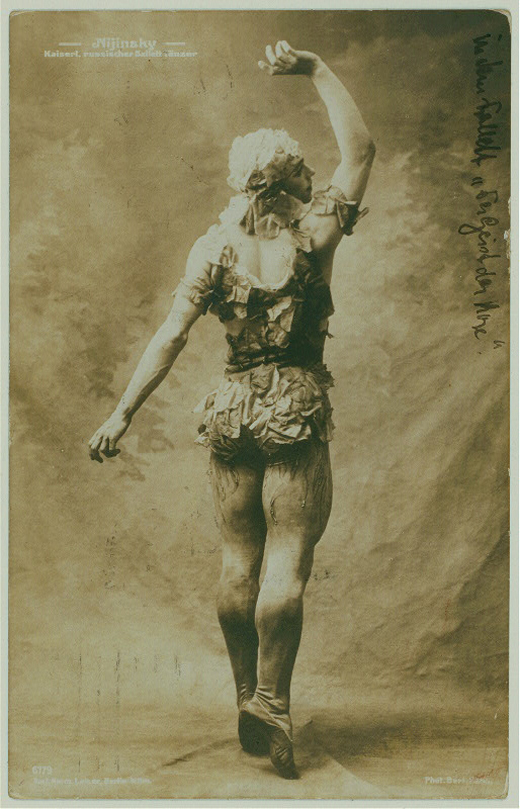
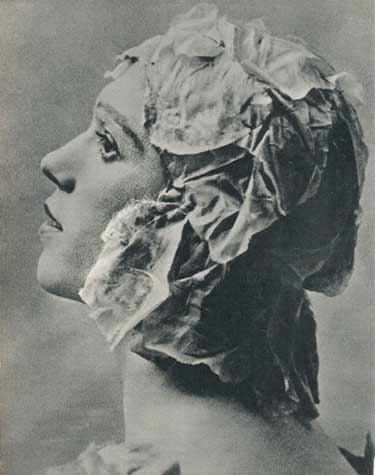
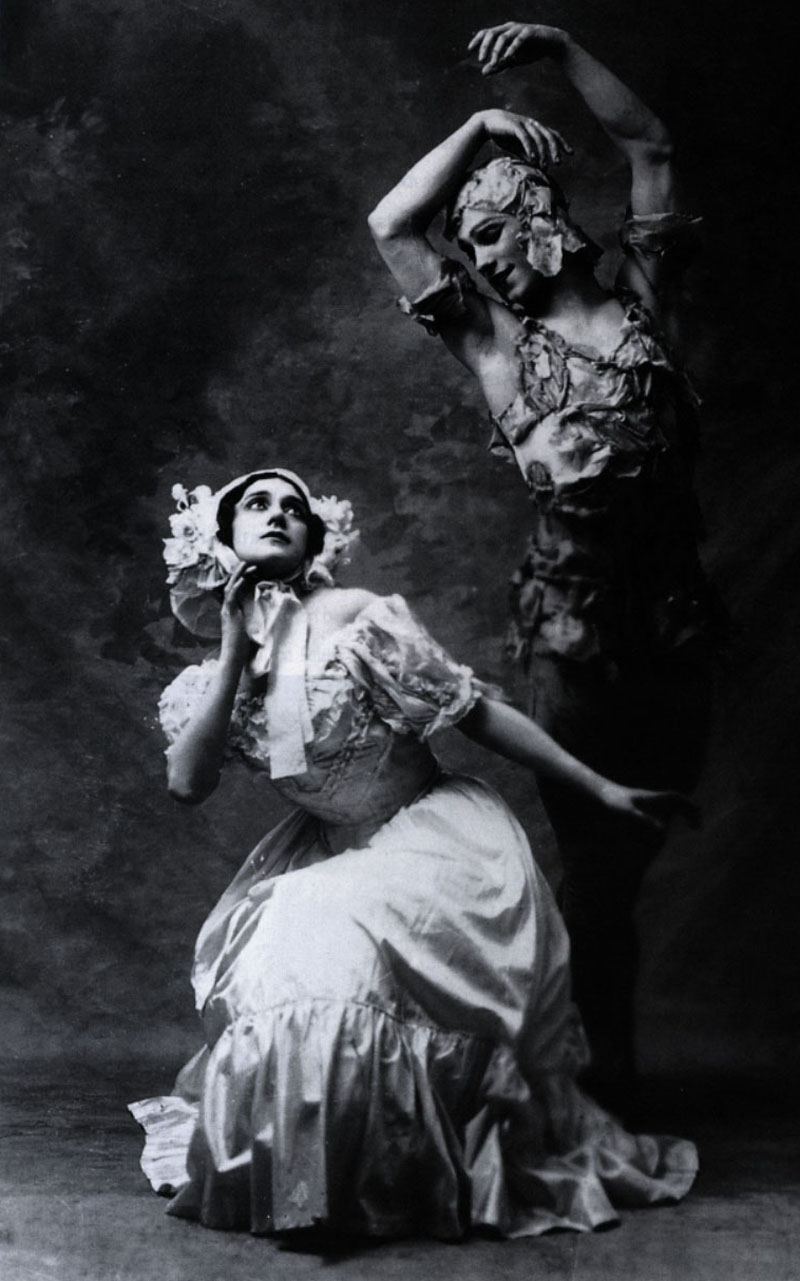
Nijinsky as the Spectre
Sunlight now streams in through the window and wakes the girl. Her mind is full of her dream-picture, of the spirit of the rose, of her lover. She looks around for him but does not find him. She sees she is alone and realizes that it has all been a dream. But there on the floor beside her chair is a red rose; she stoops to pick it up, clasping it by her, happily content with her dream.
L'Apres-midi d'un Faune
A Faun sits on a hillock, relaxing in the afternoon sun. He is eating grapes and playing the flute. Seven nymphs appear, passing through the Faun's domain on their way to bathe in the lake nearby. As they move past in line, the Faun is entranced by the beauty of the creatures and moves down from his hillside. The nymphs, in turn, are fascinated by the handsome creature, seemingly half-boy, half-animal. The Faun begins to dance playfully about the nymphs, who, frightened, flee into the forest. Only one nymph remains; she allows the Faun to come closer, even to touch her, to which she seemingly responds. But she too takes fright and rushes off to join her companion; as she leaves, a silk scarf falls from her.
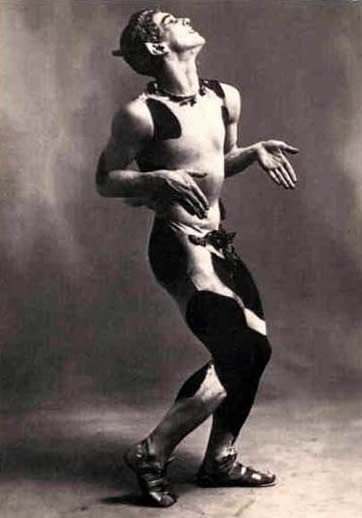
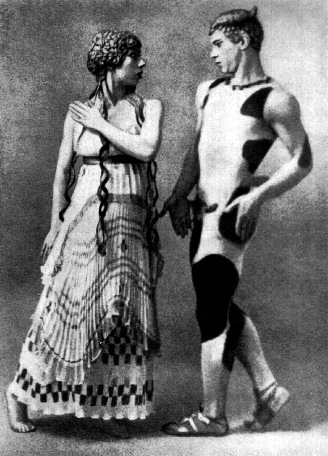
Nijinsky as the Faun
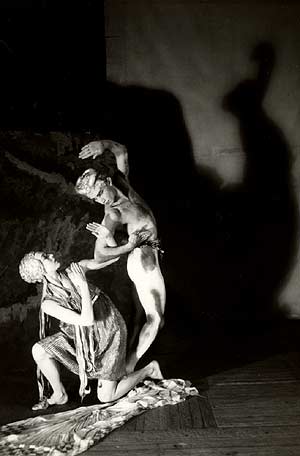
Philip Ralph, Paris Dances Diaghilev, 1990
A musical prelude recalls man's first relations with
the world about him. The curtain rises. In a wasteland scene dominated by
great masses of stone, young girls and boys sit in separate groups. They do
not move, they wait and watch, as if expecting some sign from the stone
shafts they revere. The girls rise, as if drawn by the abundance of nature
to which the music calls their attention. A wise man stands among the
dancers; the girls rush around and around him. Now he moves toward the
sacred mound of the enclosure. The girls follow and bow before him. The
opening phrase of the ballet; the quiet, plaintive cry of man against
all-powerful nature is repeated.
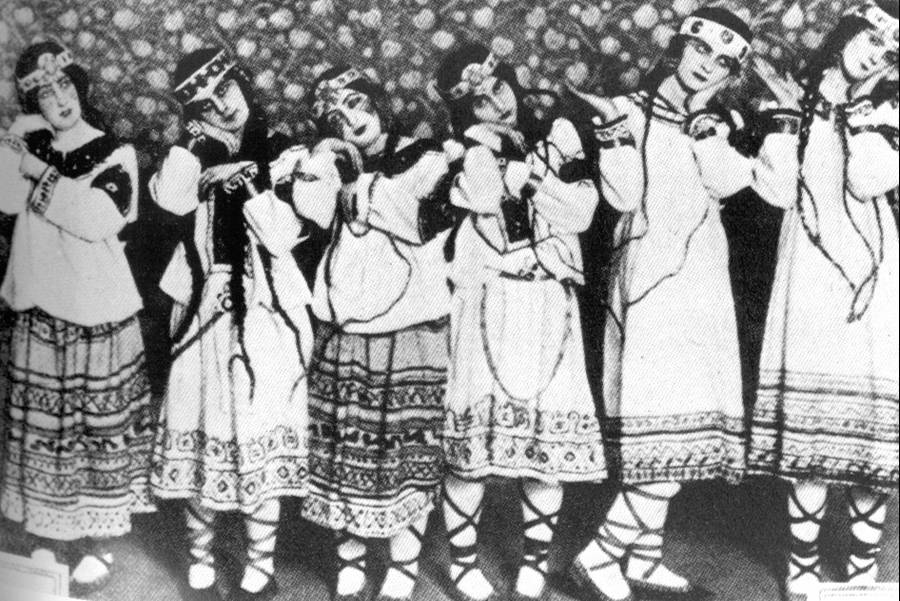
The Maidens
The strings sound strong, persistent chords that rouse the young men. To the virile beat of the music, they begin to dance, their movements accelerating at its demand, their feet stamping, stamping the earth. The girls join in the dance, the music becomes joyous, and the adolescents abandon themselves to the swift, exuberant rhythms of the orchestra.
This music changes sharply. A new, penetrating melody
shrieks warningly and disturbs the young people. The happiness of the boys
and girls shifts abruptly to fierce savagery. They split into different
groups; the boys face the girls and move toward them. The boys seem bent on
attack, but at the last minute they hesitate; they move back and forth in an
almost helpless effort, ignorant of their own intent. The rhythmic
crescendos give place to the soft trillings of the flutes. Now the boys
break their formation, and each carries a girl away.
Four boys remain on the scene. They choose four girls,
lift them up on their backs, and dance slowly, bending low under the weight
of their burdens in imitation of the plodding chords of the music. This
"Round Dance of Spring" gradually increases in volume, and all the
adolescents participate. All the dancers step back as the trilling flutes
repeat their love call.
Drums herald the beginning of a contest between two
rival tribes. Groups of men from each tribe engage in vigorous games. In the
midst of their activity, the wise man, represented in the orchestra by a
portentous melody on the tuba, tries to interrupt the games. The stronger
theme of the games at first drowns out the wise man's theme, then recedes.
The men turn to the wise man. There is a brief, taut silence, then all the
men fall to the ground and worship the earth. The drum rolls loudly and all
rise to dance, as if they had felt the pulse of the earth and been renewed
by its power. The dance grows frenzied in its intensity. The curtain falls.
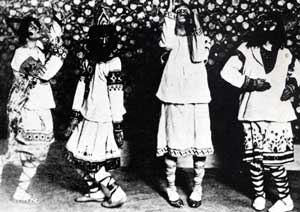

The male dancers
Second Tableau - The Sacrifice
Night is about to fall as this second scene begins; the setting sun has turned the sky scarlet. The girls sit near the wise man at a fire. One of these girls must be chosen by the others to make the sacrifice to the earth: this girl must dance herself to death. The music is calm; the figures on stage are quiet and they are unafraid. The girls regret what they have to do, but they are resigned to it with a kind of physical tiredness that the music reflects. They do not feel that they are victimized by Nature, but rather that they must obey what they believe to be its rules.
Soon the girls rise and move in the patterns of the
"Dance of the Mysterious Circles." Their movements are trancelike, as if
they themselves were not to make their dreadful decision. Their inspiration
arrives, and they rush to the periphery of the scene; the chosen one stands
alone in the center of the stage. Now begins the dance that glorifies the
victim. The chosen one remains motionless as the girls and men of the tribe
whirl around them. All are transfixed at her power. They invoke the spirit
of their ancestors, terrified anew by the force of Nature. Marking the
relentless, sharp rhythms of the music with their feet, their dance reaches
an ultimate expression of uncontrolled glory in sacrifice.
All the tribe members retire to watch the chosen one.
The orchestra sounds strong, militant chords, trumpets blare harshly,
cutting the air. The dance of the chosen begins. The brutal savagery of the
demanding music compels her to imitate it. Brief moments of comparative
quiet, which seem at first to be periods of rest and release, are in reality
more deadly because of the thrashing force that follows them. The girl is
now wholly a part of the music, part of the earth. Hypnotized by her
movements, the tribe joins in the violent dance. The chosen one begins to
lose her strength, but-forced by the convulsive violence of the music-is
endowed with a new, superhuman compulsion. When it seems that Nature can
demand no more, the girl is pushed into a fresh frenzy. Then she falls. She
is dead. The men of the tribe catch her up in their arms and hold her high
over their heads before the sacred mound. The people of the tribe rush
around her, holding up their arms. At the last slapping crescendo of the
music, they fall to the earth.
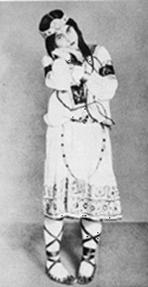
The Chosen
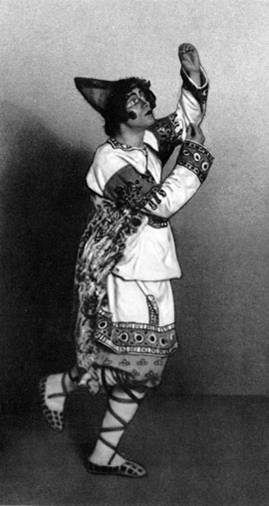
A tribesman
George Balanchine and Francis Mason